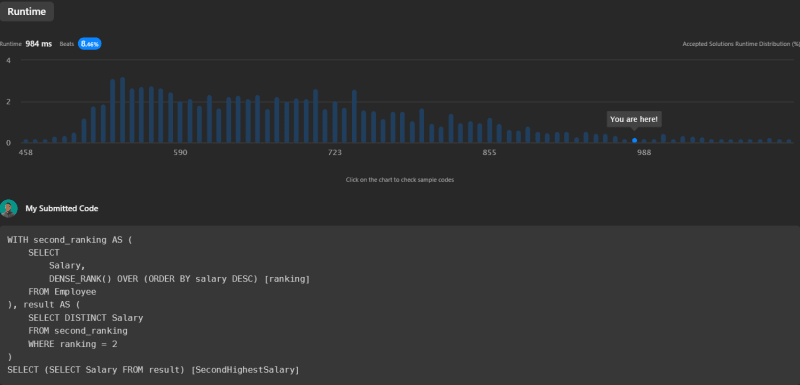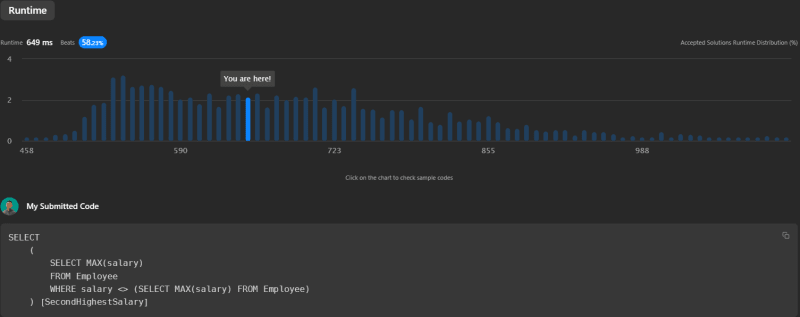Problem Statement
The structure of the Employee table is as follows:
| Column Name | Type |
|---|---|
| id | int |
| salary | int |
Here, the id is the primary key of the table and each row contains salary information for an employee.
Our objective is to write an SQL query to report the second highest salary.
Example 1:
| id | salary |
|---|---|
| 1 | 100 |
| 2 | 200 |
| 3 | 300 |
Output:
| SecondHighestSalary |
|---|
| 200 |
Example 2:
| id | salary |
|---|---|
| 1 | 100 |
Output:
| SecondHighestSalary |
|---|
| null |
Approaches to the Solution
We will explore three approaches, each using different concepts in SQL. We'll explain each method in detail, highlighting their strengths and weaknesses. Additionally, we'll also provide performance results for these solutions.
1. Using Window Function and Subquery
The first solution leverages the window function DENSE_RANK() and a subquery to return the second highest salary.
WITH second_ranking AS (
SELECT
Salary,
DENSE_RANK() OVER (ORDER BY salary DESC) [ranking]
FROM Employee
), result AS (
SELECT TOP 1 Salary
FROM second_ranking
WHERE ranking = 2
)
SELECT (SELECT Salary FROM result) [SecondHighestSalary]
In the first part of the query, we use DENSE_RANK() to rank salaries in descending order. We then filter out the second highest salary (where ranking = 2) using a subquery. Although this approach is clear and logical, its performance is not optimal, achieving a runtime of 877ms, beating 14.57% of LeetCode submissions.
2. Using Window Function, DISTINCT, and Subquery
The second solution is a variation of the first, with the addition of the DISTINCT keyword to ensure that the selected salary is unique.
WITH second_ranking AS (
SELECT
Salary,
DENSE_RANK() OVER (ORDER BY salary DESC) [ranking]
FROM Employee
), result AS (
SELECT DISTINCT Salary
FROM second_ranking
WHERE ranking = 2
)
SELECT (SELECT Salary FROM result) [SecondHighestSalary]
The use of DISTINCT adds a uniqueness condition but comes with a slight decrease in performance. This query has a runtime of 984ms, beating 8.46% of LeetCode submissions.
3. Using Subquery and MAX Function
The third solution uses a combination of subqueries and the MAX function to return the second highest salary.
SELECT
(
SELECT MAX(salary)
FROM Employee
WHERE salary <> (SELECT MAX(salary) FROM Employee)
) [SecondHighestSalary]
This solution has a much better performance, achieving a runtime of 649ms, beating 58.23% of LeetCode submissions.
Conclusion
From these three solutions, we learn that in SQL, a more straightforward approach sometimes results in better performance. Using basic SQL functions and operations (like MAX and subqueries) can outperform more complex methods involving window functions. Therefore, the third solution is ranked as the best in terms of overall performance on LeetCode.
However, please note that performance can vary significantly based on the specific RDBMS, data distribution, and table size in real-world applications. So it's important to test different methods in your specific environment.
Find the original problem on LeetCode.
For more solutions and tech-related content, connect with me on my Beacons page.






Top comments (0)